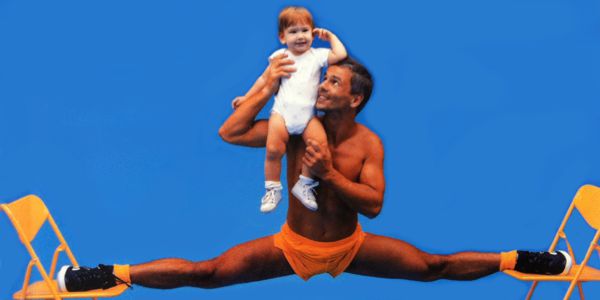This is the eighth installment of my column on training that appeared in May 2000 issue of TaeKwonDo Times. This article answers questions about practicing the high roundhouse kick.
To read the previous installment click here.
Here are two questions and answers that demonstrate the necessity of having sufficient strength, muscular endurance, and mastery of lead-up skills prior to learning how to do high roundhouse kicks. The first question is answered by Mac Mierzejewski, author of Power High Kicks with No Warm-Up! who teaches knockdown karate at Edmonton Kyokushin Karate Club in Edmonton, Alberta.
Question: I wonder with all of the “scientific” information you have if you have addressed [the issue of injury to] the knees when doing many repetitions of kicks? I have heard that these high repetitions will give knee problems. Are you aware of any of these problems and do you have any suggestions for a beginner to avoid these problems?
I am referring to past rumors and then recent personal experience, not anything I have ever seen published. The rumors I’ve heard in the past [are] that the repetitive “snapping out” of the leg to full extension will (or can) wear out the knee joint. And I have recently been working with kicks such as the Front Toe kick and Roundhouse kick, trying to get power in it from my hips, and I’ve been noticing a soreness just above the patella and a stiffness in the knees in general. Feels like tendinitis. Is this something you have ever experienced or heard of in training and are there any possible biomechanical corrections you might suggest?
Answer: Rational training strengthens the body. In my experience with hundreds of students, the great number of kicks they throw makes their knees stronger—so strong that most grappling kneelocks do not work on them.
Generally pain in exercised joints is caused by poor technique or insufficient fitness: not enough strength to properly align the limbs, not enough muscular endurance to preserve sufficient strength during long sets of repetitions, not enough flexibility to perform movements with ease. It takes a few months of general fitness training before a person is ready for learning fighting techniques.
Instructors who allow beginners to practice kicks without going through this basic training set them up for injuries. The activities of these few months, during which students learn stances, footwork, fist and foot positions while also performing variety of conditioning exercises, are needed to develop sufficient strength, muscular endurance, kinesthetic sense, balance, and flexibility—especially the mobility of hip joint.
One of the possible causes of knee and patella problems is insufficient range of rotation in the hip joint during the kick because it changes the patello-femoral tracking. You can notice that as a person spreads the legs wider when standing in a straddle stance the patellae (kneecaps) move away (to the outside) from their original position. This happens because in the straddle stance the thigh bones are made to face mostly forward while the outside part of the quadriceps pulls at the kneecap.
Something similar happens during a kick if the kicker does not have enough range of motion in the hip joint for the required amount of outside rotation of the supporting thigh and the outside part of the quadriceps of the kicking leg is tight. During kicking the quadriceps pulls the patella firmly against the thigh, and if the patella is in the wrong spot then that is where it will rub. You can try to do a roundhouse kick without rotating your supporting leg (having your supporting foot face forward or at most sideways). You should notice that the patella of your kicking leg is pulled to the side. If you do a roundhouse kick with your supporting leg fully rotated so its foot points back, the patella of the kicking leg should be in its normal position.
Another cause of joint problems is kicking “the air” rather than bags or shields. While kicking the targets, students have better control of the path of the kick, especially its final phase whereas without a solid target joints are often overextended (what you call “snapping out” of the leg to full extension).
Mac Mierzejewski, Author of Power High Kicks with No Warm-Up!
Question: I am a 48-year-old female in very good physical condition. I tore the anterior cruciate ligament in my knee while doing a roundhouse drill. My heel wasn’t lifted when I kicked the target. With the full body weight turning, my knee took a good torque. Is it possible, if allowed, to get back into class at 4 months?
Answer: I have tried to recreate the situation that lead to your ACL tear and I could not. I did it two ways, one—with a turn on the ball of the foot and raising the heel, and the second—planting the whole foot and turning on that whole foot (the “shoving” roundhouse kick). I could not do it in such a manner as to feel any torque on the knee of the supporting leg. My guess is that your injury was caused by any or all of the following:
1. Poor explanation and demonstration of the technique.
2. Wrong sequence of teaching lead-up skills enumerated in the previous article of this column (Taekwondo Times March 2000) prior to teaching the roundhouse kick.
3. Not enough drilling in the lead-up skills in previous months so the skill of correct synchronization of the turn of the supporting foot and of the rotation of hips was not permanently instilled.
4. Insufficient strength of legs for practicing this technique.
5. Poor sport-specific endurance (see point 3), which caused fatigue and desynchronization and discoordination in your technique.
6. Fatigue resulting from conditioning exercises (strength, muscular endurance) done during the workout prior to fighting and kicking drills. It is a common practice for bad instructors to lead their class through fatiguing conditioning prior to technical drills. They call it “warm-up” but it is not. Warm-up is not supposed to fatigue.
7. Static stretching prior to kicking drills. Such stretching is detrimental to neuromuscular coordination and can predispose one for an injury. In the next article of this column I will deal with this issue at greater length.
In the light of the above I would question the sense of ever returning to this class.
Thomas Kurz
To read the next installment of this column click here.
This article is based on the book Stretching Scientifically.
This article is copyrighted © [March 1999] by Stadion Publishing Company, Inc. and posted with their permission. Original articles of Thomas Kurz’s column on stretching and training are at https://www.stadion.com/articles-on-training-for-sports-and-martial-arts/
References
Kurz, T. 1994. Stretching Scientifically: A Guide to Flexibility Training. Island Pond, VT: Stadion Publishing Co. Inc.
Mierzejewski, M. 1996. Power High Kicks with No Warm-Up! Island Pond, VT: Stadion Publishing Co. Inc.










